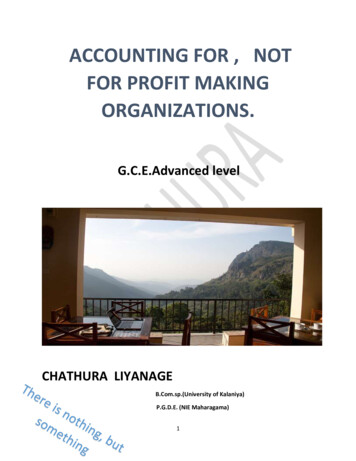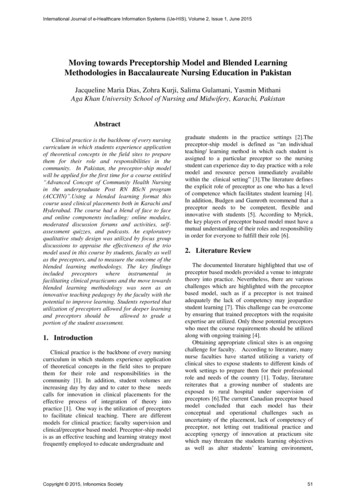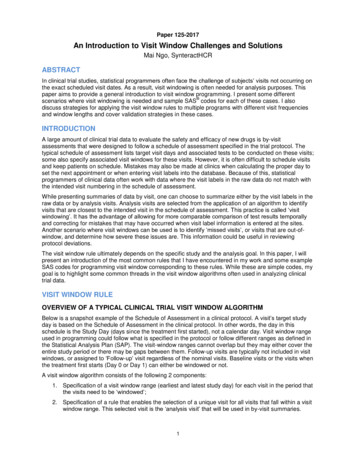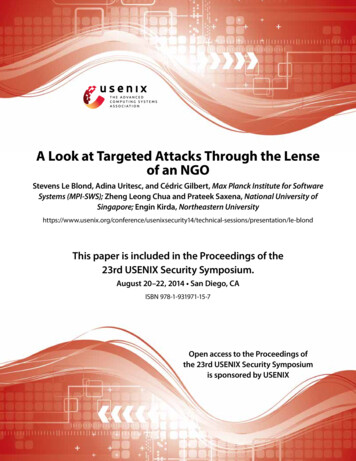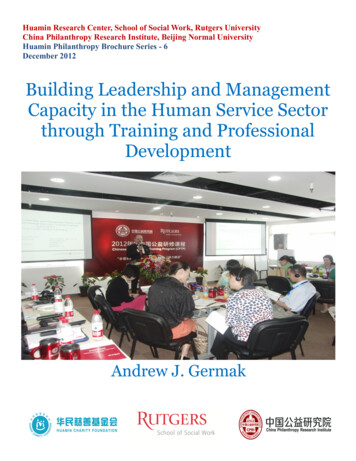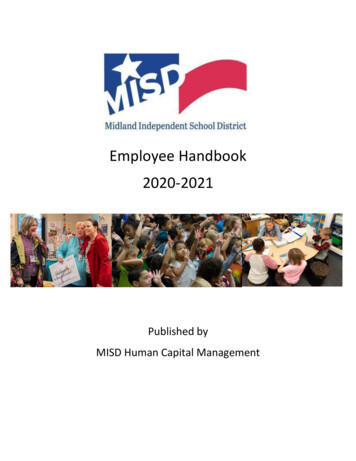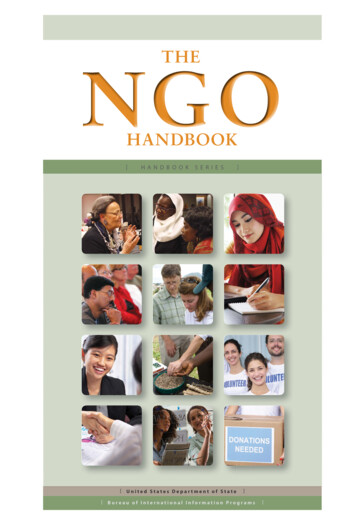
Transcription
THENGOHANDBOOK[[[HAN D B O O KSER I E SUnited States Department of State]]Bureau of International Information Programs]
About the AuthorMosaica Senior Consultant HilaryBinder-Aviles is the lead author of thishandbook. Mosaica: The Center forNonprofit Development and Pluralism is amulticultural, nonprofit, capacity-building organizationthat provides tools to NGOs to build just, inclusiveand thriving communities and societies. For the past20 years, Mosaica has provided training and assistancein the areas of NGO startups, program/organizationalplanning and management, evaluation, governance,fundraising, advocacy, and community organizing.Mosaica’s special commitment is to groups that serveand represent populations whose voices are least likely(Courtesy of Hilary Binder-Aviles)to be heard when policies are made and resources are allocated.Binder-Aviles has extensive experience working with U.S.-based NGOs started byrefugees and immigrants from Africa, Southeast Asia, Latin America and the Arab world.She has facilitated planning and coalition building for Iraqi, Yemeni and Egyptian NGOs.Binder-Aviles holds a bachelor’s degree in political science from Wellesley College anda master’s in public policy from the John F. Kennedy School of Government at HarvardUniversity. Mosaica founder Emily Gantz McKay and Vice President Hila Berl providedfeedback, insights, and examples based on their combined decades of experience workingwith NGOs in the United States and in places of conflict, including the Middle East, theformer Yugoslavia, Pakistan, and Afghanistan.
THE NGO HANDBOOKC O N T E N T SHave you ever seen a problem and wanted to do something about it?Of course you have. The schools, police, government welfare offices,churches and families aren’t handling it. Others share your concernsand want to do something. That’s why you would start a nongovernmentalorganization, or NGO. This handbook will guide you throughthe steps of starting and operating an NGO.Introduction123A Powerful Wayto Bring AboutChangeStarting andSustainingan NGOValues, Visionand Mission —the CompassPlanning,Evaluating andManaging4567The BoardofDirectorsCommunityParticipation andEmpowermentPartnerships withOther NGOs andGovernmentThe Funders —Foundations,Corporations,Individuals[2][ 36 ]Bibliography [ 75 ][6][ 48 ][ 14 ][ 56 ][ 22 ][ 64 ]
Introduction:A POWERFUL WAY TO BRINGABOUT CHANGENongovernmental organizations (NGOs) advocate for human rights andenvironmental protection, build youth leadership, work to end violenceagainst women and children, assist the poor and much more. Starting anNGO can be a powerful way to bring about change.( 2000-2012 PhotoSpin, Inc.)
NGOs — nongovernmentalorganizations — are independentof both the government and thebusiness sector. Their mandate is topromote the public interest and serve thepublic good rather than to make a profitor advance the interests of a narrow groupof individuals. Their independence enablesthem to monitor government performanceand advocate for improvements.NGOs that are respected by both thegovernment and the business sector canhelp mediate conflicts or find solutionsto common concerns. Finally, theirindependence from government, politicalparties and religious institutions allowsthem to create a shared vision for theircommunity. NGOs mobilize volunteersand other resources to achieve their vision.Whether you are thinking aboutstarting an NGO, have already establishedone, or have been leading one for years,you are part of a global movement ofpeople channeling their power to effectchange. Over the past few decades,NGOs have been at the forefront ofmajor social movements to better people’slives. The number of NGOs in emergingdemocracies has grown rapidly over thepast decades. In places such as the formerSoviet republics, NGOs are helping builddemocratic institutions and provide safetynets for poor and vulnerable populations.The term “NGO” first came into useafter World War II when the UnitedNations applied it to private organizationsthat helped heal the ravages of the war— millions of displaced people, orphansand high unemployment. But the conceptof citizens organizing around issues goesback much further. Some scholars identifythe first international NGO as AntiSlavery International, established in 1839.Today, the U.N. recognizes an estimated40,000 international NGOs, with millionsmore operating within countries. Thereare many different kinds of NGOs. Someare large, multinational organizationswhile others are small, village-basedgroups. Some target particular issuesor sectors, such as women, youth, theenvironment, human rights, educationor health. Others address multiple issuesand sectors.Whatever their area or scope, all NGOsexist to make people’s lives better orsolve a social problem. Most NGOs arefounded by people who are passionateabout their communities or causes. Yetstarting and running an NGO takes morethan passion. It takes knowledge, skills,resources and relationships. It also takestime, planning, patience and flexibility.This handbook provides a frameworkfor building an effective, sustainableNGO. In these pages, you will findinformation about how to develop the corecomponents of an NGO — the values,vision, mission and programs — and tipsfor how to carry them out. We will alsocover the different kinds of relationshipsyou need — with the community youserve, your partners, your funders, thegovernment and other stakeholders.Throughout the book, you will find bestpractices for running an NGO and adviceon how to avoid and address commonchallenges your NGO might face.Ultimately, this handbook will helpyou build an NGO that is legitimate,transparent and accountable, qualitiesnecessary for your NGO to be effective.LEGITIMACYWhen an NGO is seen as legitimate,the public believes that it addresses aneed in society and that its members putthat social need above their personalinterests. Before you ask yourself: Howdo we sustain our NGO?, you need toanswer the questions: Are we legitimate?and Does our NGO deserve to exist?An NGO deserves to exist when it has a3
clear, relevant mission focused on meetinga critical community or societal need.But a good mission is not enough. To belegitimate, an NGO must also be wellgoverned, well run and effective.An NGO that is controlled by oneindividual will not be seen as legitimate.If one person dominates an organizationwith little input or oversight from others,that individual risks promoting his orher personal interest over the publicinterest. Without the active leadership andmanagement of several people, there areno checks and balances to prevent misuseor abuse of NGO resources. An NGOneeds a broad base of leaders who solicitinput from stakeholders to make sure theirorganization serves the public interest.ACCOUNTABILITYBecause an NGO exists for the publicgood, it must be accountable to — answerto — the public. Specifically, that meansanswering to your stakeholders: funders,members, partners, the people you serve,the community you operate in andother NGOs.Different stakeholders have differentexpectations. Your funders expecttheir money to be used for the intendedpurpose, managed well and applied tomeet project objectives. The people youserve expect help with their needs and tobe treated with respect. Partners expectyou to be honest and follow throughon commitments. These are just a fewexamples. NGOs need to engage andlisten to their different stakeholders tounderstand their varied expectations. At aminimum, your NGO is accountable for: The mission: An NGO’s mission is whyit exists. It is your public promise aboutwhat you do and the difference you seekto make in the world. An NGO keepsits promise to the public by upholdingits mission.4KEEP IN MIND NO ONE OWNS AN NGOThroughout this handbook, we may referto “your NGO.” By that we mean the NGOwith which you are affiliated. An NGO is notsomeone’s property. It serves the publicgood and must have a group of peoplewho serve as the stewards of that publictrust. This is typically the board of directors.NGOs that are controlled by one individualwho is not accountable to a board or otherstakeholders will not be seen as legitimateand will not earn the diverse supportneeded to sustain the organization. The results: It is not enough to carryout projects and activities. An NGOmust achieve tangible results inimproving the lives of the peopleit serves. Good governance: Your NGO shouldhave a volunteer board of directorsthat governs the organization ethicallyand effectively. Governance is the setof activities through which a boardprovides direction and oversight of theorganization and its activities. Fiscal responsibility: Your NGO mustmake sure the contributions it receivesare used to advance the mission, not forthe personal gain of specific individuals.In its governance role, the boardoversees the NGO’s finances.How do you hold your NGOaccountable? Too often, NGOs holdthemselves accountable only to theirfunders and donors and not to theircommunities. Your funders, of course,require you to report to them, while yourcommunities do not. In many countries,government ministries that oversee NGOsrequire annual reports. But how doNGOs hold themselves accountable to the
communities they serve? They do that byholding community meetings, conductingsurveys, and writing annual reports,newsletters and other forms of outreach.Not only should you regularly inform yourconstituency of your activities, you shouldseek their input and feedback. If NGOsdemand accountability in others, theymust be accountable themselves.TRANSPARENCYWhen something is transparent, you cansee through it. That is how NGOs mustoperate. Stakeholders must be able to seeinto your organization and understandhow its programs operate, how funds areused and how decisions are made. AnNGO practices transparency by providingtimely and accurate information about itsactivities, finances, policies, proceduresand decisions. By being transparent, youcreate opportunities to learn how to doyour work better. When others haveinformation about what you are doing andhow you are doing it, they can offer ideasfor improvement.REMEMBER Legitimacy, transparency andaccountability go hand in hand. Ifan NGO is not accountable to itsstakeholders, it will not be seen aslegitimate. If an NGO is not transparent,it cannot hold itself accountable andneither can others. Further, beingaccountable and transparent helps youbuild trust with the community. Earningyour community’s trust is key to beingable to carry out your mission. Whencommunity members lack trust in anNGO, they are less likely to participate inits programs or seek its services. The moreaccountable and transparent you are, themore trust you gain. And the more trustyou gain, the better able you are to serveyour community.It is up to you as an NGO leader touphold these principles, for they are thekeys to your success.When one NGO makes headlines forcorruption or mismanagement, it makesall NGOs look bad, and the whole sectorloses legitimacy in the eyes of the public.On the other hand, when NGOs upholdthese principles in word and action, theybuild confidence and trust in the work ofall NGOs. This handbook will help yourorganization do just that.OTHER TERMS FOR NGOsYou may hear other terms used to describeorganizations that work to advance thepublic good: Civil society organizations (CSOs) Nonprofit organizations Charities or charitable organizations Grassroots or community-basedorganizations Voluntary organizationsIn some cases, the terms suggest aparticular type of NGO. For example,grassroots organizations are NGOs thatmembers of a community form to helpthemselves.5
1STARTING AND SUSTAININGAN NGO( 2003-2012 Shutterstock Images LLC)6
Solutions to large global challengesoften start with small, local actions.When you see a need or a problemin your community, you can makea difference by standing up and takingaction. An artist may see youth in hisneighborhood with nothing to do afterschool and start an informal art program.An educator may notice that young girlsfrom poor families don’t attend schoolregularly and set up a Saturday tutoringprogram. A nurse may learn that womenin her community are uninformedabout basic health services and organizeinformational workshops.But, no matter what kind of challenge oropportunity you face, you can accomplishmore when you have more resources andpeople supporting your goal than whenyou act alone. This is why you start anongovernmental organization (NGO).Starting an NGO requires many kindsof support. You need volunteers, peoplewho provide resources and advocates whobelieve in your efforts. Launching projectsand activities demands multiple skillsand forms of support. You need to makeplans, reach out to the community, recruitvolunteers, raise funds, monitor projectsand evaluate results. Sustaining an NGOover time demands an even greater levelof commitment, skills, systems, supportand resources.This chapter provides an overviewof the key components to start andsustain an NGO. As we discussed inthe introduction, when an NGO islegitimate — accountable, transparent,and connected to the community — thenit deserves to be sustained. Sustainabilityrefers to the capacity of an NGO tomaintain its activities over time. Often,when we hear the term sustainability, thefirst thing that jumps to mind is money.But sustainability is about much morethan that. It starts with the organization’svision and mission.VISION AND MISSION STATEMENTSYour NGO’s vision describes the longterm changes you seek and how people’slives will be better thanks to your work.Your mission is the unique way yourorganization contributes to turning thatvision into reality. It is necessary that youput your vision and mission into writing.When the leaders of an NGO share apowerful vision and a clear mission, theNGO has a much better chance to besuccessful. Without a vision, your NGOwill find it hard to inspire others to joinyour cause. An ill-defined mission leavesan NGO without focus and direction.NGOs with unclear missions oftendissipate their energy in many unrelatedprojects or activities, leaving little impact.Writing vision and mission statementsis one of the most important things you,the founders of an NGO, do. Vision andmission statements set the tone for yourfuture work. In the beginning, set asidetime for your core leadership team tocome together and define your NGO’saims and means to accomplish them.As your NGO gains experience, or asnew needs emerge in the community, youwill likely need to refine your mission.Imagine a lawyer who wants to helpmigrant workers in his city. He starts anNGO called Migrant Workers’ SupportNetwork (MWSN). Initially, his missionis broad: Help migrant workers. Later,he realizes the mission is too broad andhis NGO lacks focus. So he narrowsthe mission to: Advocate for the rightsof migrant workers in detention. Nowhe knows exactly where to channel theNGO’s resources. But as time passes, hediscovers other unaddressed needs that hisNGO can meet, such as improving housingand working conditions, so he decidesto redefine his mission again: Supportmigrant workers to live with safety,security and dignity in our community.7
Periodic review and reaffirmation ofthe mission is part of an NGO’s ongoingstrategic planning process. If at any pointyour staff, board and key volunteersdisagree about what your NGO shouldbe doing, or if your funders and partnersshow signs of losing confidence, thatmight signal the need to revisit yourmission.ADDRESSING COMMUNITY NEEDSAn NGO must be able to translate itsmission into projects and activities thathave measurable impacts welcomed by thecommunity. Projects must be thoughtfullydesigned and carried out by qualifiedpeople in order to effect lasting changeand receive long-term funding.When you are starting out, start small.MWSN has a basket of ideas for projectsto empower migrant workers: an afterwork education program, recreationalactivities to build community, an artworkshop for the children of migrantTRY THIS BUILD YOUR TRACK RECORDEven if you have a lot of good ideas, startsmall. Pick one or two projects that yourgroup can do well. If immigrants are yourfocus, try an after-work education projectfor migrant workers or their children. Bydoing one or two projects well the NGObuilds a track record of success and learnswhat it takes to be effective.workers and a public education campaignabout how migrant workers contribute tosociety. But its leaders wisely realize thatdoing all these at once would be biting offmore than they can chew. Instead, theypick one or two projects and do them well.This way, the NGO can build up a trackrecord of success and learn what it takesto be effective. If you are uncertain aboutthe best place to start, conduct a simplecommunity survey or needs assessment.The hypothetical NGO Migrant Workers’ Support Network aims to assist people such as this migrant workerin a Vidalia onion farm in Georgia. ( AP Images/David Goldman)8
This young girl in India’s remote Rann of Kutch, in Gujarat, is the child of a migrant salt worker. Such a childmight benefit from an NGO focused on helping migrant laborers and their families, like the NGO suggestedin this chapter. ( AP Images/Prakash Hatvalne)As your NGO matures, its projects andactivities will evolve in response to thechanging needs of the community as wellas your own lessons learned. You mightdecide to expand some activities and cutback on others or completely restructureyour programs.MWSN has launched an after-workeducation program for migrant workersand found that there was high interestbut low participation. After conductinga survey, the NGO found the reason wasthat the immigrants did not have child-WHAT IS THE BOARD OF DIRECTORSOF AN NGO?The board of directors is the bodyresponsible for governing the organization.The board makes sure an NGO’s mission iscarried out legally, ethically and effectively.Ultimately, the board is accountable to thecommunity the NGO serves, its donors andother partners.care facilities in the evenings. MWSNsolved this by partnering with anothergroup to add child-care assistance tothe program.NGOs must regularly evaluate howwell their projects and activities meet thecommunity’s needs and interests. Youneed to end programs that are no longerrelevant or effective and focus on thosethat are, especially when money is scarce.When your NGO can show that it ismeeting community needs and producingmeasurable results, you will stand a goodchance of securing the resources andsupport to be sustainable.THE PILLARS OF SUSTAINABILITY:PLANNING, MANAGEMENT,EVALUATIONSustainability requires systems forplanning, management and evaluation.Regular planning must take place atmultiple levels: project plans, fundraisingplans, overall organizational plans, short9
WHAT IS EVALUATION ANDWHY IS IT IMPORTANT?Evaluation is the systematic review andassessment of the benefits, quality andvalue of a program, activity or organizationas a whole. An evaluation asks: What worked? What could have worked better? Why did certain things work or not work? What difference did the work make forour community? What did we learn and how do we usethat knowledge?more sophisticated systems as you needthem. When you begin to raise larger sumsof money from multiple sources, thenyou can acquire financial managementsoftware and detailed accountingprocedures. Having clear policies andprocedures and well-defined roles andresponsibilities for management will helpyour NGO’s projects, activities and overallorganization run smoothly. And when thathappens, your donors and supporters willhave confidence their resources are beingused well.COMMITTED LEADERSHIPterm plans, long-term plans. Planningsystems enable you to organize yourwork, respond to needs and anticipatechallenges. Management systemsare the tools to establish clearresponsibilities and procedures forhandling everything from moneyand staff to projects and timelines.Finally, evaluation systems informyou of the results you are achieving.To be accountable, you need toreport results not just to yourfunders and supporters, but also tothe community you serve.Sometimes, new NGOs do notthink about setting up systems.After all, most people start NGOsbecause they want to contribute toa cause, not because they want tocreate administrative procedures,develop budgets and write reports.But you must set down at leastsimple policies and basic procedures.At a minimum, you need to setup a database to track incomeand expenses, and establish fiscalcontrols such as who can approvepayments and who can sign checks.As your NGO grows, you will havemore things to manage: projects, people,money, relationships. You can develop10Building and sustaining an NGO takespeople with different kinds of knowledgeand skills: project managers, proposalThe NGO Pragya, “wisdom” in Sanskrit, runs thisschool bus that serves migrant workercommunities in Central Himalayan villages in India.( Andrew Aitchison/In Pictures/Corbis)
writers, website developers, fundraisersand survey takers, to name a few.But, above all, NGOs need leaders —people committed to the organization andwilling to spend time and effort directingits work. Typically, the leadership groupconsists of an executive director, seniorstaff and the board of directors. AnNGO’s leaders take on extra responsibilityfor making sure the NGO has a clearmission, effective programs and efficientmanagement of its resources.When an NGO is starting up, it iscommon for the founder to invite friends,family members and colleagues to jointhe board. However, as an NGO matures,the founder and board will need to bringin new leadership from outside. Thefounder and founding board membersof the MWSN might realize they need abanker or business owner with financialexpertise to advise on budgets, or someonefrom the faith community to ask churchesto provide food and shelter to migrants.Board members should make a list of thekinds of experts their NGO needs anddraw up a plan for recruiting them. Newboard members from outside can bringfresh perspectives and energy to the NGO.Sustainable NGOs continuouslycultivate new leadership at all levels — theboard of directors, staff, volunteers, andprogram participants and beneficiaries.WHAT IS A RESOURCE DEVELOPMENTPLAN?A resource development plan is one ofthe many types of plans an NGO needsto sustain its work. It includes your NGO’stotal funding needs for the year andspecific goals for the amount of moneyyou aim to raise from each of your differentsources. It also includes a work plan to meetthese goals with specific activities, tasks,responsibilities and deadlines.NGOs that are dependent on just oneleader, or a small clique of leaders,have shortcomings that can affect theirlongevity and effectiveness. Some NGOshave shut down when their foundersdeparted because there was no one elsewith enough knowledge or commitmentto keep them going. Others have lost thetrust of the community when foundingleaders refused to make space for newleaders to come on. Still other NGOshave become irrelevant and ineffectivebecause they failed to attract new anddiverse talent.Your NGO should constantly workto identify and recruit new talent, buildtheir leadership skills, and move them intopositions of responsibility.RELATIONSHIPS WITHSTAKEHOLDERSGroups and individuals that care aboutthe same issues and interact with manyof the same people as your NGO arestakeholders in your organization. Theyhave a stake in your work.Relationships with a broad range ofstakeholders — business and professionalassociations, donor organizations, faithinstitutions, coalitions, unions, politicalparties and informal community groups— allow an NGO to thrive. Stakeholdersprovide your NGO resources — notjust financial support but also in-kindsupport. For example, one of the MWSN’sstakeholders owns a printing business. Thestakeholder prints materials for MWSN atreduced cost. Or a professional associationwith a stake in MWSN’s work may recruitprofessionals from a particular field tomentor migrant workers.Building relationships with stakeholderscreates a network of allies who willchampion your NGO’s cause and defendits rights, and those of your community.Imagine that MWSN has been working11
to get the local government to considerpassing legislation to protect the rightsof migrant workers. The organization ismore likely to be successful if it can getletters of support from many stakeholders— other NGOs, businesses, faith leadersand community leaders.Strong relationships are based on sharedgoals, trust and mutual benefit. Regardlessof where your NGO is in its lifecycle— whether it is just starting or wellestablished — you need to invest time andenergy in building relationships with thesediverse stakeholders. The relationshipswill change over time, but they are alwayscritical to your NGO’s sustainability.DIVERSITY IN FUNDING SOURCESAn NGO should not rely on a singlefunder, such as a wealthy businessowner, or a single type of funder, suchas foundations, for its survival. If yoursource of funding changes priorities orfaces financial problems, your NGO maybecome insolvent and have to close. Toavoid that, your NGO should seek a widevariety of funding sources, includingfoundations, businesses, governments andindividuals. An NGO may also generateincome by selling products or services andholding community fundraising events.With diversified funding, if one source offunding ends, others can help make upfor the loss.Building a diversified funding baserequires the collective effort of an NGO’sstaff, board and volunteers. You will needa fundraising plan that lays out objectives,strategies, tasks and timelines. Involve allyour staff, board members, volunteers,and even community members in helpingto raise funds. Create a fundraisingcommittee to coordinate the work andmonitor progress.Building a diversified base of fundingtakes time. Keep in mind that manyNGOs start without formal grants orThe Haitian NGO Fondation Seguin partnered with USAID to involve schoolchildren in a tree-plantingprogram in Parc National La Visite, Haiti. Children from neighborhoods devastated by the 2010 earthquakehelp fight deforestation and learn about the environment. (Kendra Helmer/USAID/Haiti)12
WHAT IS “IN-KIND” SUPPORT?In-kind support refers to items donated toyour NGO. They have monetary value, butyour NGO does not have to pay for them.Common examples include donations ofsupplies and materials, equipment, andmeeting or office space. In-kind support canalso include donations of time and expertise,such as a graphic designer who designsyour NGO’s website. You must keep track ofin-kind support in your NGO’s budget.long-term sources of funding. Theyget volunteers and startup donations,then seek funding from foundations,government agencies and the generalpublic once they have results to showfor their efforts. Some funders give seedgrants to new organizations. Seed fundersunderstand that new NGOs do not havelong records of success and are willing totake a risk on a good idea and the peoplewho will carry it out. When courting aseed funder, write up a detailed proposaldescribing what you plan to do and howyou plan to do it, as well as a descriptionof the qualifications of the NGO’s leaders.Many NGOs struggle in their first yearswith only one or two funding sources.However, this is the time to build a diversebase of funding for the future.CONCLUSIONA clear mission and vision; relevantand effective projects and activities;good planning, management andevaluation; committed leadership; strongrelationships; and a diverse base offinancial support are the building blocksthat sustain an NGO over time. From themoment you found an NGO, think aboutsustainability at every step. For example,when you carry out strategic planning,assess your NGO’s strengths and set goalsfor improving its weaknesses to promotethe organization’s long-term viability.There are key decision points in anorganization’s lifecycle that are vital toits sustainability. Whenever your NGOis considering launching a new projector activity, entering a new partnership,or hiring new staff, stop and assess yourcapacity to sustain the new endeavor.Ask yourself: Does it fit our mission? Isit needed and wanted by the communitywe serve? Do we have a good plan andcan we manage it well? Do we haverelationships with stakeholders who cansupport or partner with us? And, can weraise the resources we need to start up andmaintain the project over time?An NGO is a powerful way to createlasting change for your community.Through it, you can mobilize others andbuild something bigger than what youcan achieve alone. But it is a long journeyand a lot of work. It takes years and manykinds of skills, resources and relationshipsto build and sustain an effective NGO.Remember our hypothetical example: Thefounder of the MWSN started with a coreleadership team, clarified his mission, andlater diversified the leadership to bring innew skills, expertise and relationships.The organization started by carrying outa small number of projects, set up systemsto make sure they were well run, evaluatedthem to find out if they were making adifference, and began to raise moneyfrom diverse sources. With these buildingblocks in place, the MWSN has a strongfoundation on which to grow. This meansthat more migrant workers will be able tolive with safety, security and dignity.13
2VALUES, VISION AND MISSION— THE COMPASS( Jon Feingersh Photography/SuperStock/Corbis)14
An NGO’s values, vision and missionare its compass. They guide everydecision an NGO makes andevery action it takes. Putting intowriting your values, vision and mission isone of the first steps you must take whenyou found an NGO. These statementswill direct the rest of your journey andcommunicate to your stakeholders whoyou are and what you stand for.An NGO is more likely to be successfulwhen its leaders agree on its core values,share a powerful v
Good governance: Your NGO should have a volunteer board of directors that governs the organization ethically and effectively. Governance is the set of activities through which a board provides direction and oversight of the organization and its activities. Fiscal responsibili




